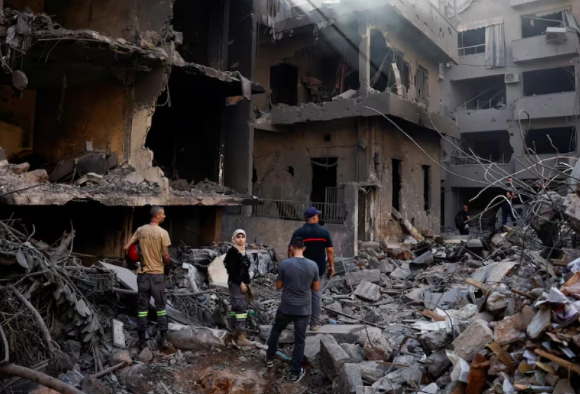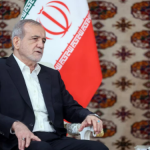Hezbollah is gearing up for a protracted war of attrition in southern Lebanon following the elimination of its top leadership by Israel, with a new military command now overseeing rocket fire and ground operations, according to two sources familiar with its activities.
After suffering heavy losses from three weeks of intense Israeli strikes, including the assassination of its leader Sayyed Hassan Nasrallah, Hezbollah is being closely watched by both allies and adversaries to see how effectively it can resist Israeli forces that have crossed into Lebanon with the aim of pushing it away from the border.
Despite waves of Israeli airstrikes that have, according to Israel, significantly reduced Hezbollah’s arsenal, the group still has a large stockpile of weapons, including powerful precision-guided missiles that have yet to be deployed, said four sources familiar with its operations.
Following Nasrallah’s assassination on September 27, along with other Hezbollah leaders and an Iranian commander in an Israeli strike on his bunker in Beirut, the group’s chain of command was temporarily disrupted. However, 72 hours later, a new “operations room” was established, the two sources—a Hezbollah field commander and a source close to the group—told Reuters.
The new command has continued to function despite further Israeli attacks, enabling fighters in southern Lebanon to continue firing rockets and engaging in combat under centralized orders, the sources explained, requesting anonymity due to the sensitivity of the information.
A third source, a senior official with close ties to Hezbollah, confirmed that the group is now engaged in a war of attrition. Avraham Levine, an analyst at the Israeli think tank Alma, said Hezbollah remains a formidable adversary and is likely “well prepared and waiting” for Israeli troops. “The chain of command being damaged doesn’t eliminate their ability to attack Israeli communities or target Israeli forces,” Levine told Reuters, referring to Hezbollah as “the same powerful terror army we know.”
Hezbollah fighters, according to the field commander, are capable of executing orders based on the front-line conditions. He described the new command as a “narrow circle” in direct communication with field units. Speaking to international media is rare for a Hezbollah field commander, who added that the new command operates with complete secrecy and did not disclose any details regarding its communication methods or structure.
Though Hezbollah has not publicly named a new leader after Nasrallah’s death, with the most likely successor also killed, Sheikh Naim Qassem, the group’s deputy leader, voiced support for ceasefire efforts earlier this week but insisted that Hezbollah’s capabilities remain intact.
Another source familiar with Hezbollah’s operations stated that the group’s fixed-line phone network has been critical for communication during this period. The network reportedly survived Israeli strikes on Hezbollah’s communications infrastructure in September.
In a statement signed by the “operations room of the Islamic Resistance,” Hezbollah claimed that its fighters are actively resisting Israeli incursions and monitoring Israeli troops from unexpected positions—suggesting concealed operations. This was the first public acknowledgment of the existence of a new command, though the statement did not disclose any names or specify the context of its establishment.
When approached for comment, Hezbollah’s media office did not respond prior to publication. Following the release of the story, the office issued a written statement denying the claims attributed to the Hezbollah field commander, asserting that “there are no sources in Hezbollah,” and stating that those portions of the Reuters story were “completely false.”
When asked about the situation in Lebanon, the Israel Defence Forces (IDF) referred Reuters to their earlier public statements. Israel announced on October 1 that its ground forces had entered southern Lebanon, beginning with commando units and later supported by regular armored and infantry units. On Tuesday, the military confirmed that reservists from the 146th Division were now on the ground, bringing the total number of divisions deployed in Lebanon to four. Israel has not disclosed the exact number of troops involved, but a typical Israeli division is composed of over 1,000 soldiers.
According to Israel, the troops are engaged in close-quarters combat with Hezbollah units. The Israeli military has reported that 12 of its soldiers have been killed in southern Lebanon and northern Israel since the operation began.
Both Hezbollah and Israel have acknowledged the existence of Hezbollah’s extensive tunnel network in southern Lebanon, which Israel estimates to stretch for hundreds of kilometers. This network reportedly expanded after Hezbollah’s 2006 war with Israel, according to a 2021 report by the Alma think tank. The Hezbollah field commander emphasized that the tunnels are “the foundation of the battle,” noting that the group had spent years building them in preparation for such a conflict. “Their time has come,” he said.
Israel’s military has released video footage that it claims shows its soldiers capturing Hezbollah tunnels, including one video from October 5 that appears to depict an underground room equipped with fixed-line telephones. However, Reuters has been unable to verify the footage’s location or date. A source close to Hezbollah said the tunnels detected by Israel were constructed for the group’s Radwan special forces, designed for future incursions into northern Israel’s Galilee region. The source further stated that Israel does not fully understand the extent of the tunnel network.
Hezbollah has faced significant losses in this conflict but is still capable of launching rocket attacks against Israel. Andreas Krieg, a senior lecturer at King’s College London’s School of Security Studies, noted that while Hezbollah’s capabilities have been diminished, the group continues to fire rockets into Israel and is holding back its more potent ballistic missiles for potential later use.
Prior to the current conflict, the U.S. Central Intelligence Agency’s World Factbook estimated that Hezbollah had over 150,000 missiles and rockets. Two sources familiar with Hezbollah’s operations indicated that the group has refrained from using its most advanced precision-guided missiles, preserving them for a prolonged war and to avoid providing Israel with justification to strike major Lebanese infrastructure, such as the Beirut airport or key roads and bridges. The third source confirmed that Hezbollah had not targeted major Israeli cities, like Tel Aviv, with its most powerful rockets for the same reason, as it would provoke an even more devastating response from Israel.
While Israel has dealt a heavy blow to Hezbollah, particularly through the detonation of thousands of Hezbollah’s booby-trapped communications devices in September—an attack Israel has neither confirmed nor denied—it is clear that Hezbollah remains a formidable force. Beginning on September 23, Israel intensified its airstrikes, claiming to have destroyed tens of thousands of Hezbollah rockets, particularly in southern Lebanon, the Bekaa Valley, and the southern suburbs of Beirut. Israeli officials have noted that Hezbollah is launching an average of 100-200 missiles per day, far below the thousands anticipated, which they claim indicates that Hezbollah’s arsenal has been significantly weakened.
Estimates vary regarding the full extent of Hezbollah’s losses, with one Western diplomat suggesting that up to 25% of Hezbollah’s missile capacity had been lost even before Nasrallah’s assassination. Reuters has also reported that Iran had offered to replenish Hezbollah’s supplies, though logistical challenges along the supply routes have hampered these efforts.
The Israeli military claims to have killed hundreds of Hezbollah fighters, including a significant portion of the senior command of its elite Radwan special forces. The United States, which designates Hezbollah as a terrorist organization, pointed to Hezbollah’s deputy leader Sheikh Naim Qassem’s recent call for a ceasefire as a sign of the group’s weakened position.
In the context of ongoing guerrilla tactics, Hezbollah has been employing ambushes and anti-tank weapons against advancing Israeli forces. In one particularly deadly encounter last week, concealed Hezbollah fighters launched a surprise attack on Israeli troops near Odaisseh, a village in southern Lebanon. The ambush involved mines and Russian-made Kornet anti-tank missiles, similar to those used by Hezbollah during the 2006 war with Israel. This incident is believed to be the same one where the Israeli military reported that five of its soldiers were killed, and five others severely injured, in a gun battle on October 2.
Israel’s broader objective is to restore security and enable the return of tens of thousands of Israeli citizens who fled the northern regions following Hezbollah’s rocket attacks in solidarity with Hamas in Gaza. On the Lebanese side, authorities say that more than 1 million people, primarily from the Shi’ite community which forms Hezbollah’s support base, have been displaced due to Israel’s military operations.
Mohanad Hage Ali, an expert at the Carnegie Middle East Center, suggested that Israeli forces are likely to continue their advance, with the primary question being the extent of the resistance Hezbollah can offer. The south of Lebanon holds deep significance for Hezbollah, as the group was originally founded in the early 1980s with support from Iran’s Revolutionary Guards to counter an Israeli invasion and occupation of southern Lebanon. This region has since become a key battleground for the group.
Andreas Krieg, from King’s College London, emphasized that ground combat with Israel is central to Hezbollah’s strategy, which is designed specifically for such engagements. Hezbollah aims to signal to Israel and its allies, as well as its own base in Lebanon and the broader Iran-backed Axis of Resistance, that despite the losses, it remains a potent force capable of causing significant damage to Israeli forces.



